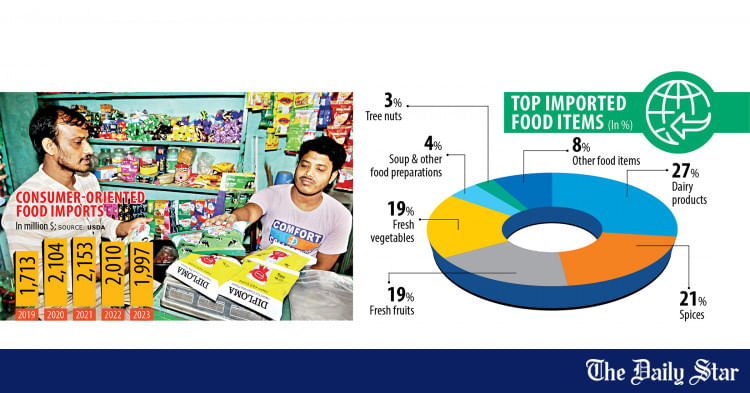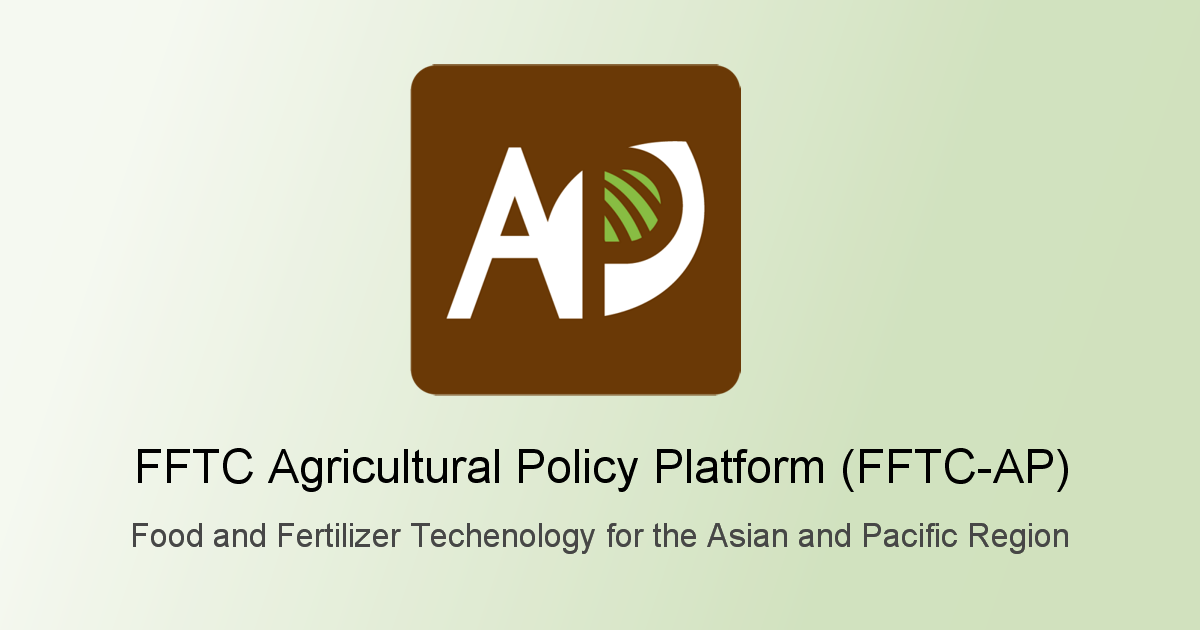Saif
Senior Member
- Jan 24, 2024
- 11,472
- 6,422
- Origin

- Residence

- Axis Group

Agro-food processing industry in Bangladesh: An overview
The agro-food processing industry constitutes an important industry in the manufacturing sector in most countries. This industry is an important part of the manufacturing sector in Bangladesh which now accounts for about 20 percent of gross domestic product (GDP) of the country. The agro-food processing industry now contributes about 8.0 per cent to manufacturing output (1.7 per cent of GDP). Despite maintaining sustained growth in output over the last decade or so, its share of GDP remains quite static below 2.0 per cent. This is indicative of the industry's failure to achieve a higher growth rate relative to other industries, in particular the RMG (ready-made garment) industry which seems to overwhelmingly dominate the manufacturing activity in Bangladesh.
According to the UN Food and Agriculture Organisation (FAO), agro-processing involves the transformation of products originating from agriculture, forestry and fisheries. Agro-food processing involves primary and secondary processing. The former is associated with processing of agricultural products in their basic form and the latter requires conversion into final products like jams, biscuits etc. The primary inputs for the industry include crops, poultry and livestock, fishery and some forestry products.
This industry now employs about 2.2 per cent of total workforce in the country of which close to 70 per cent are unskilled labour. Its share of total exports now stands at around 1.5 per cent. Some researchers indicate that the country has much higher potential to explore enhancement of exports from this industry as reflected in their estimated revealed comparative advantage (RCA). Bangladesh now exports about US$400 million processed agro-food products and has the potential to rise further in the near future given the RCA.
As the Bangladesh economy continues to grow, the size of the middle-income population will continue to rise. The estimated size of the middle-income population is around 35 million. Also sustained economic growth is causing rapid urbanisation. Both sustained economic growth and urbanisation have already caused changes in dietary intake where processed food has become an important element in their consumption basket.
Furthermore, with the rise of two-income families the demand for processed packaged food is also on the rise. All these factors are now contributing to a rapidly growing domestic market for a whole range of processed food including ready-to-eat meals. But there is also now a market that exists to cater to the needs of rural population where 40 per cent of the country's people live. However, that market growth is constrained by rural poverty as most poor people are largely but not exclusively live in rural areas. For these poor people hunger remains a daily reality. The 2019 Global Hunger Index puts Bangladesh in the 88th position out of 117 countries with a score of 25.8, indicating the country suffers from a level of hunger that is considered as serious.
While a part of the manufacturing sector the agro-food processing industry remains closely integrated with the agriculture sector. In Bangladesh, 40 per cent of workforce is now in the agriculture sector. More importantly, the industry remains at the centre of all economic activities within the complex food system to ensure food supply for the population using mostly the market mechanism. Even where still subsistence farming exists, farmers there also have to interface with the market however limited that encounter might be.
The industry is rather very fragmented in terms of the products it produces. Also, due its close proximity to agriculture, the industry is fragmented in geographical space within the country. Each of the sub-industry (e.g. cereals, dairy products, edible oil, snack food etc) has its own distinct characteristics in terms of input, technological and management requirements. However, the industry is mostly composed of small and medium firms with a limited number of large firms, numbering 500+, mirroring the global agro-food industry in its structure.
The geographic fragmentation is further contributed by the lack of well-developed transport system in the country. Quite often infrastructural deficiencies deter entrepreneurs to locate production and raw material procurement centres in areas where these raw materials are abundantly produced. Thus, an element of implicit delocalisation of production facilities is quite evident and that does not currently benefits farmers in those areas.
These fragmentations stand in the way to achieving economies of scale by firms within the industry which in turn has implications for achieving price competitiveness in the domestic and the international market. While the industry helps to reduce post-harvest crop losses (estimated at 30-40 per cent), it does not help to smoothing extreme price fluctuations in the immediate post-harvest period. However, the agro-food processing industry has the capacity to transform perishable agricultural products into storable and transportable goods which benefit farmers.
The agro-food processing industry remains highly concentrated and dominated by a limited number of firms, thus the market can be described as oligopolistic in nature. Such concentration of market power enables these firms to use their market power in depressing the price of agricultural inputs taking advantage of seasonality of agricultural output. The supply chain between the farm and the processing unit is also marked by agents and traders which works against the financial interest of farmers. At the global level, the picture is very similar where the processed food market is dominated by a limited number of multinational firms like Nestle (Switzerland), Unilever (Netherlands) and a few others.
But most pressing issue facing the industry remains the food safety (non-toxic food) issue. This problem starts right at the farm level where the use of pesticides, insecticides and fertilizer is very common, then flows on to the production and packaging levels as reflected in the presence of harmful chemicals in many processed food items in Bangladesh. They all together negatively impact on the domestic demand for processed food. The industry has a vital role to play to ensure consumer food safety which will enable the country to achieve the objective as defined by the FAO in 1996 to ensure food for all that is of good quality in sufficient quantities and in accordance with local cultures.
The industry has been increasingly focusing on export markets. Bangladesh exported US$374 million in 2017-18 which was a 41 per cent increase from the previous year. The captains of the industry believe that the country is poised to hit US$1.0 billion in export earnings from this industry by 2020-21. Bangladesh government provides both tax holidays and cash incentives for exporting processed food. But granting of such incentives for export promotion remains very problematic from the economic efficiency point of view. In fact, such micro-level industry-specific incentives can lead to macroeconomic inefficiency by distorting efficient allocation of resources.
The main exports from this industry are composed of frozen fish, shrimp and other frozen food products, tea, spices, fruits including dry fruits and some other processed agricultural products. The major export destinations include the European Union (EU), the US, the middle East and the Gulf, but targeting ethnic food niches in those countries with strong presence of Bangladeshi and South Asian migrants and settled communities from those countries.
Global trade in agricultural and food products has been increasing at a rapid rate but the trend does not benefit developing countries whose share of global trade in agro-food remains much less than developed countries. However, developing countries such as Brazil and China are emerging as major players over the last two decades. Bangladesh now designated as a least developed country enjoys preferential market entry into developed world markets like the EU but subject to fulfilling such criteria as the Rules of Origin which requires a very high level of domestic content and domestic value addition in exported products. When Bangladesh officially becomes a developing country, that privilege will no longer be accorded.
International trade in food is subject to numerous constraints known as technical barriers to trade. Every country has its own food safety standards and requirements to protect consumers. The most often used reasons to apply regulatory instruments to reject imported food include - food containing filth, decayed and decomposed or other harmful substance; toxic substances such as pesticide, insecticide, melamine or lead; veterinary and agricultural drugs.
However, the objective of the World Trade Organisation (WTO) is to ensure that regulations are purely designed to protect consumers not as non-tariff barriers (NTB). Two agreements have been appended to the list of WTO agreements to address the issue of NTB. They are - Agreement on Sanitary and Phytosanitary measures (SPS) and the revised Agreement on Technical Barriers to Trade (TBT). Also, Geographic Indications (GIs) may be relevant in certain cases. So, it is important that to stimulate exports of agro-processed food products, Bangladesh needs to focus particularly on food safety laws and standards. In this respect the role of relevant domestic institutions to ensure food safety is of paramount importance. While Bangladesh may follow its own path, yet all food safety measures as encapsulated in food safety regulations adopted by the country must be aligned with the internationally recognised food safety standards and also the process of implementation of those regulations must be seen to be transparent.
Muhammad Mahmood is an independent economic and political analyst.
According to the UN Food and Agriculture Organisation (FAO), agro-processing involves the transformation of products originating from agriculture, forestry and fisheries. Agro-food processing involves primary and secondary processing. The former is associated with processing of agricultural products in their basic form and the latter requires conversion into final products like jams, biscuits etc. The primary inputs for the industry include crops, poultry and livestock, fishery and some forestry products.
This industry now employs about 2.2 per cent of total workforce in the country of which close to 70 per cent are unskilled labour. Its share of total exports now stands at around 1.5 per cent. Some researchers indicate that the country has much higher potential to explore enhancement of exports from this industry as reflected in their estimated revealed comparative advantage (RCA). Bangladesh now exports about US$400 million processed agro-food products and has the potential to rise further in the near future given the RCA.
As the Bangladesh economy continues to grow, the size of the middle-income population will continue to rise. The estimated size of the middle-income population is around 35 million. Also sustained economic growth is causing rapid urbanisation. Both sustained economic growth and urbanisation have already caused changes in dietary intake where processed food has become an important element in their consumption basket.
Furthermore, with the rise of two-income families the demand for processed packaged food is also on the rise. All these factors are now contributing to a rapidly growing domestic market for a whole range of processed food including ready-to-eat meals. But there is also now a market that exists to cater to the needs of rural population where 40 per cent of the country's people live. However, that market growth is constrained by rural poverty as most poor people are largely but not exclusively live in rural areas. For these poor people hunger remains a daily reality. The 2019 Global Hunger Index puts Bangladesh in the 88th position out of 117 countries with a score of 25.8, indicating the country suffers from a level of hunger that is considered as serious.
While a part of the manufacturing sector the agro-food processing industry remains closely integrated with the agriculture sector. In Bangladesh, 40 per cent of workforce is now in the agriculture sector. More importantly, the industry remains at the centre of all economic activities within the complex food system to ensure food supply for the population using mostly the market mechanism. Even where still subsistence farming exists, farmers there also have to interface with the market however limited that encounter might be.
The industry is rather very fragmented in terms of the products it produces. Also, due its close proximity to agriculture, the industry is fragmented in geographical space within the country. Each of the sub-industry (e.g. cereals, dairy products, edible oil, snack food etc) has its own distinct characteristics in terms of input, technological and management requirements. However, the industry is mostly composed of small and medium firms with a limited number of large firms, numbering 500+, mirroring the global agro-food industry in its structure.
The geographic fragmentation is further contributed by the lack of well-developed transport system in the country. Quite often infrastructural deficiencies deter entrepreneurs to locate production and raw material procurement centres in areas where these raw materials are abundantly produced. Thus, an element of implicit delocalisation of production facilities is quite evident and that does not currently benefits farmers in those areas.
These fragmentations stand in the way to achieving economies of scale by firms within the industry which in turn has implications for achieving price competitiveness in the domestic and the international market. While the industry helps to reduce post-harvest crop losses (estimated at 30-40 per cent), it does not help to smoothing extreme price fluctuations in the immediate post-harvest period. However, the agro-food processing industry has the capacity to transform perishable agricultural products into storable and transportable goods which benefit farmers.
The agro-food processing industry remains highly concentrated and dominated by a limited number of firms, thus the market can be described as oligopolistic in nature. Such concentration of market power enables these firms to use their market power in depressing the price of agricultural inputs taking advantage of seasonality of agricultural output. The supply chain between the farm and the processing unit is also marked by agents and traders which works against the financial interest of farmers. At the global level, the picture is very similar where the processed food market is dominated by a limited number of multinational firms like Nestle (Switzerland), Unilever (Netherlands) and a few others.
But most pressing issue facing the industry remains the food safety (non-toxic food) issue. This problem starts right at the farm level where the use of pesticides, insecticides and fertilizer is very common, then flows on to the production and packaging levels as reflected in the presence of harmful chemicals in many processed food items in Bangladesh. They all together negatively impact on the domestic demand for processed food. The industry has a vital role to play to ensure consumer food safety which will enable the country to achieve the objective as defined by the FAO in 1996 to ensure food for all that is of good quality in sufficient quantities and in accordance with local cultures.
The industry has been increasingly focusing on export markets. Bangladesh exported US$374 million in 2017-18 which was a 41 per cent increase from the previous year. The captains of the industry believe that the country is poised to hit US$1.0 billion in export earnings from this industry by 2020-21. Bangladesh government provides both tax holidays and cash incentives for exporting processed food. But granting of such incentives for export promotion remains very problematic from the economic efficiency point of view. In fact, such micro-level industry-specific incentives can lead to macroeconomic inefficiency by distorting efficient allocation of resources.
The main exports from this industry are composed of frozen fish, shrimp and other frozen food products, tea, spices, fruits including dry fruits and some other processed agricultural products. The major export destinations include the European Union (EU), the US, the middle East and the Gulf, but targeting ethnic food niches in those countries with strong presence of Bangladeshi and South Asian migrants and settled communities from those countries.
Global trade in agricultural and food products has been increasing at a rapid rate but the trend does not benefit developing countries whose share of global trade in agro-food remains much less than developed countries. However, developing countries such as Brazil and China are emerging as major players over the last two decades. Bangladesh now designated as a least developed country enjoys preferential market entry into developed world markets like the EU but subject to fulfilling such criteria as the Rules of Origin which requires a very high level of domestic content and domestic value addition in exported products. When Bangladesh officially becomes a developing country, that privilege will no longer be accorded.
International trade in food is subject to numerous constraints known as technical barriers to trade. Every country has its own food safety standards and requirements to protect consumers. The most often used reasons to apply regulatory instruments to reject imported food include - food containing filth, decayed and decomposed or other harmful substance; toxic substances such as pesticide, insecticide, melamine or lead; veterinary and agricultural drugs.
However, the objective of the World Trade Organisation (WTO) is to ensure that regulations are purely designed to protect consumers not as non-tariff barriers (NTB). Two agreements have been appended to the list of WTO agreements to address the issue of NTB. They are - Agreement on Sanitary and Phytosanitary measures (SPS) and the revised Agreement on Technical Barriers to Trade (TBT). Also, Geographic Indications (GIs) may be relevant in certain cases. So, it is important that to stimulate exports of agro-processed food products, Bangladesh needs to focus particularly on food safety laws and standards. In this respect the role of relevant domestic institutions to ensure food safety is of paramount importance. While Bangladesh may follow its own path, yet all food safety measures as encapsulated in food safety regulations adopted by the country must be aligned with the internationally recognised food safety standards and also the process of implementation of those regulations must be seen to be transparent.
Muhammad Mahmood is an independent economic and political analyst.














 For all latest news, follow The Daily Star's Google News channel.
For all latest news, follow The Daily Star's Google News channel.